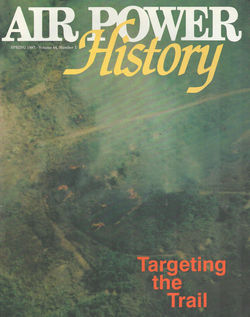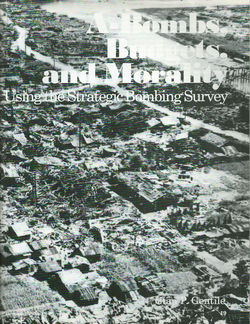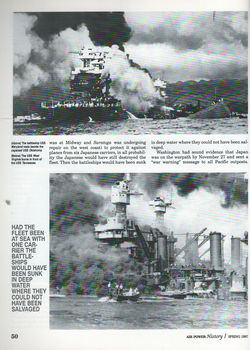AIR
POWER HISTORY SPR 97 VIETNAM HO CHI MINH TRAIL SOVIET PILOTS IN KOREAN WAR B-38
VIETNAM WAR: TARGETING THE HO
CHI MINH TRAIL
ATOMIC BOMBS, BUDGETS AND
MORALITY: USING THE STRATEGIC BOMBING SURVEY
SOVIET PILOTS IN THE KOREAN WAR
LESSONS IN AIR POWER FROM PEARL
HARBOR ATTACK 1941
BOEING / VEGA B-38 - The XB-38
Flying Fortress was a single example conversion of a production B-17E Flying
Fortress, testing whether the Allison V-1710 V type engine could be substituted
for the standard Wright R-1820 radial engine during early World War II.
--------------------------------
On 14 December 1964, the U.S.
Air Force's (USAF) "Operation Barrel Roll" carried out the first
systematic bombardment of the Hồ Chí Minh Trail in Laos. On 20 March 1965,
after the initiation of Operation Rolling Thunder against North Vietnam,
President Lyndon B. Johnson approved a corresponding escalation against the
trail system. "Barrel Roll" continued in northeastern Laos while the
southern panhandle was bombed in "Operation Steel Tiger".
By mid-year the number of
sorties being flown had grown from 20 to 1,000 per month. In January 1965, the
U.S. command in Saigon requested control over bombing operations in the areas
of Laos adjacent to South Vietnam's five northernmost provinces, claiming that
the area was part of the "extended battlefield". The request was
granted by the Joint Chiefs of Staff. The area fell under the auspices of
"Operation Tiger Hound".
Political considerations
complicated aerial operations. But the seasonal monsoons that hindered
communist supply operations in Laos also hampered the interdiction effort.
These efforts were hindered by morning fog and overcast, and by the smoke and
haze produced by the slash-and-burn agriculture practiced by the indigenous
population. During 1968 the USAF undertook two experimental operations that it
hoped would worsen the monsoons. "Project Popeye" was an attempt to
indefinitely extend the rainy season over southeastern Laos by cloud seeding.
Testing on the project began in September above the Kong River watershed that
ran through the Steel Tiger and Tiger Hound areas. Clouds were seeded by air
with silver iodide smoke and then activated by launching a fuse fired from a
flare pistol. Fifty-six tests were conducted by October; 85% were judged to be
successful. President Johnson then gave authorization for the program, which
lasted until July 1972.
Testing on the second operation,
"Project Commando Lava", began on 17 May: scientists from Dow
Chemical had created a chemical concoction that, when mixed with rainwater,
destabilized the soil and created mud. The program drew enthusiasm from its
military and civilian participants, who claimed that they were there to
"make mud, not war." In some areas it worked, depending on the makeup
of the soil. The chemicals were dropped by C-130A aircraft, but the overall
effect on North Vietnamese interdiction was minimal and the experiment was
cancelled.
Defoliation
In December 1965 the USAF began
its first Operation Ranch Hand defoliation missions against the trail in Laos
using both Agent Blue and Agent Orange defoliants. More than 210 missions took
place, spraying approximately 1.8 million litres of defoliants. Unlike Laos,
the trail in Cambodia was not systematically targeted for defoliation, although
more than ten missions were mounted against the Parrot's Beak area, spraying
approximately 155,000 litres of Agent Orange.
Of all the weapons systems used
against the trail, according to the official North Vietnamese history of the
conflict, the AC-130 Spectre fixed-wing gunship was the most formidable
adversary. The Spectres "established control over and successfully suppressed,
to a certain extent at least, our nighttime supply operations". The
history claimed that allied aircraft destroyed some 4,000 trucks during the
1970–71 dry season, of which the C-130s alone destroyed 2,432 trucks.
VAH-21, nicknamed the
Roadrunners, was a short-lived Heavy Attack Squadron of the U.S. Navy, based at
Naval Station Sangley Point, Philippines. The squadron flew the specialized
AP-2H version of the Lockheed P-2 Neptune aircraft, of which four examples were
converted from standard SP-2H airframes.
The
squadron was established on 1 September 1968, as the first squadron in the Navy
with a night interdiction mission using new electronic surveillance equipment.
Its mission was to interdict logistics moving over land or sea. A detachment of
VAH-21 was immediately established at a Navy facility associated with Cam Ranh
Air Base, South Vietnam. The detachment had been a Naval Air Test Center
Project TRIM Detachment (TRIM: Trails Roads Interdiction Multi-sensor) prior to
becoming a VAH-21 detachment. VAH-21 was disestablished on 16 June 1969.








